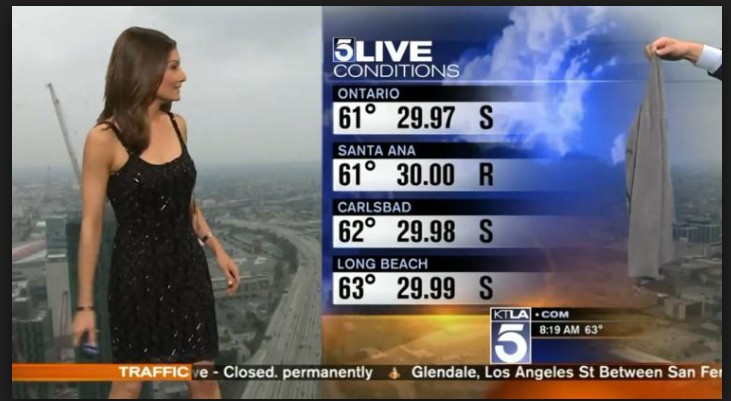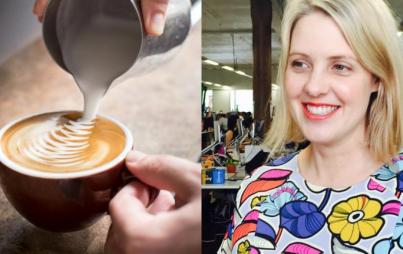
The expectation of women in TV news to appear exactly as viewers want them to normalizes the commodification of a woman’s (ANY woman’s) appearance. Image: KTLA/screenshot.
Maybe she chose to wear that dress, but it’s not like her producers didn’t see her before she went on the air.
The first time a viewer sent me a mean email about my looks was in 2003, when I had my first big job.
“Big job” is relative, of course. I was 23 years old and anchoring my own newscast in Winnipeg, Canada, so it was big for me.
You need to get rid of that shirt, the email read, It’s awful. You look pregnant.
A decade later when I actually was pregnant with my son, I was reporting on a flood so serious that tens of thousands of people were displaced, some even killed.
The seriousness of the disaster was not what one viewer took away from my report:
You need to find some dignity, and find looser-fitting maternity clothes.
God forbid my shirt be so loose I look pregnant. And if I am pregnant, God forbid my shirt be so tight it shows!
Yet, over the course of my 15 years on the air, these two emails are actually kind, compared to what some people said.
The expectation of women in TV news to appear exactly as viewers want them to normalizes the commodification of a woman’s (any woman’s) appearance.
And now, Liberté Chan, a weather anchor at KTLA in Los Angeles, was handed a sweater by her male co-anchor and told to cover up on-air because of these types of viewer emails. People watching her weather report determined that her dress, which showed her arms, was too revealing.
This is ironic, because so many of us who have worked in news have felt a trend toward wearing less and less clothing. When I began in television journalism in the early 2000s, it would have been a major faux pas to have bare arms. Now, sleeveless dresses are routinely provided by clothing sponsors and style consultants.
The pressure this puts on female journalists to maintain the physique to support this, even though that has nothing to do with their jobs, is a whole other article.
In the case of Ms. Chan, it seems her straps were just a few inches too thin for the viewers. Literally. There’s a photo of her wearing another black dress that has straps that appear to be an inch wider. She was not asked to wear a sweater with it.

The viewers’ concern over this highly-qualified professional’s inch of shoulder was so worrying for Ms. Chan’s coworkers that they couldn’t even wait until commercial to admonish her, instead treating her like a high school girl whose skirt didn’t pass the fingertip test.
Something tells me if her male co-worker’s tie was particularly hideous that day, or if he had decided not to shave, she wouldn’t have been tasked with admonishing him live on the air.
Handing him a razor and a mirror while the cameras rolled? I don’t see it happening.
On her blog, Ms. Chan says it was all in fun. Regardless of the precise dynamics behind what happened, the interaction perpetuates the old story that a woman’s appearance is there for the consumption of others.
The expectation of women in TV news to appear exactly as viewers want them to normalizes the commodification of a woman’s (any woman’s) appearance: Wear sexy dresses, but not too sexy. Be personable — but not a real person, like, all pregnant and stuff, ew.
One pregnant anchor got so much backlash about her changing shape, she took to shaming her hatemailers in the newspaper. A fat-shamed anchor offered some well-deserved sass on Facebook and it became national news.
It’s certainly possible that some outfits (maybe even the outfit Chan was wearing) are inappropriate for some workplaces, for whatever reason.
However, if a boss is called upon to offer feedback that a sartorial choice is inappropriate, there is only one place to do it: in an office, behind a closed door, where stakes are low.
Not on live television, where someone's professional credibility is impugned for all to see.
Maybe she chose to wear that dress, but it’s not like her producers didn’t see her before she went on the air. She had the tacit support of those around her until she got complaints.
Then they handed her a sweater and hung her out to dry.








